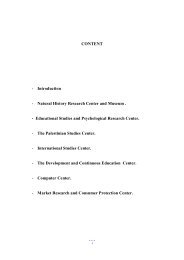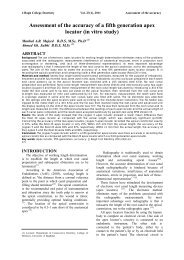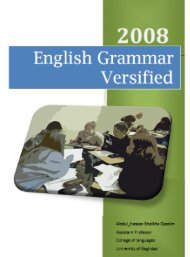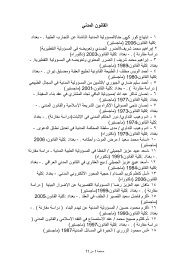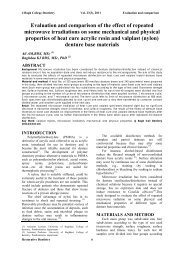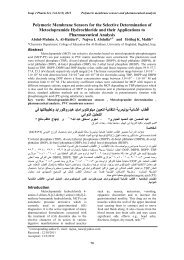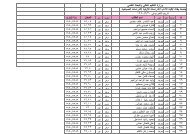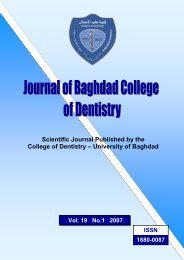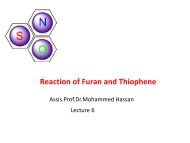Vol 21 No. 1
Vol 21 No. 1
Vol 21 No. 1
Create successful ePaper yourself
Turn your PDF publications into a flip-book with our unique Google optimized e-Paper software.
J Bagh College Dentistry <strong>Vol</strong>. <strong>21</strong>(1), 2009 The effect of using different …..<br />
The effect of using different impression techniques and<br />
materials on vertical tissue displacement in free end<br />
extension ridges. (Dental survey and clinical study)<br />
Rawia. N. AL- Dafaii, B.D.S., MSc. (1)<br />
Amir. M. Khamas, B.D.S., M.S.D. ( 2)<br />
ABSTRACT<br />
Background: Various impression techniques used in the construction of free- end extension partial denture are based<br />
on theories relative to the compressibility and behaviour of the soft tissue during impression making and during<br />
function, the aim of the study was to measure vertical tissue displacement during impression making for free- and<br />
extension using different impression technique and materials.<br />
Material and methods: the study consisted of two parts (question are and clinical) the questionnaire was circulated<br />
among (90) dentists at different working places, to see which impression technique they use in free- and extension. In<br />
the clinical part (24) mandibular distal extension impression were made using three impression techniques and<br />
materials (special tray with alginate, special tray with polyether and double tray with zinc- oxide eugenol impression<br />
paste). The amount of vertical tissue displacement was measured on stone cast using (dial indicator dimension).<br />
Results: The results of the survey showed that (44%) of the dentist tend to use special tray with alginate, and (38.1%) of<br />
prosthodontist use double tray impression, the clinical part showed that there was significant difference between the<br />
impression techniques.<br />
Conclusions: The most popular impression technique used is special tray with alginate, which showed more tissue<br />
displacement in the clinical part of the study, while the double tray impression technique showed the least<br />
displacement.<br />
Keyword: Tissue displacement, free- end extension, impression technique. J Bagh Coll Dentistry 2009; <strong>21</strong>(1):9-14)<br />
INTRODUCITON<br />
The major problem that may face the dentist<br />
during making impression is the soft tissue<br />
displacement, since the oral tissue is of varying<br />
degree of displacability according to their health<br />
and support. To provide physiologically and<br />
mechanically acceptable function, it is<br />
fundamental that the soft tissue must be copied<br />
with out distortion to prevent impingement and<br />
injury by the prosthesis (1) . In the impressionmaking<br />
procedure for free-end extension<br />
removable partial denture, the pressure produced<br />
at eh interface of he soft mucosal tissue and the<br />
impression is the most important factor for the<br />
stability of the saddle under functional load (2) . To<br />
achieve an impression with minimum tissue<br />
displacement, soft tissue displacement,<br />
impression concepts, impression techniques, and<br />
impression materials are to be taken in<br />
consideration, studies were carried out to<br />
evaluate and measure tissue displacement of freeend<br />
extension during impression making (3-5) . One<br />
study showed that the space between the inner<br />
surface of the tray and mucosal tissue, the flow<br />
of the impression material, and the size of the<br />
tray are interrelated with each other (6) .<br />
(1) Private practice<br />
(2) Assistant professor, Department of Prosthodontics, College<br />
of Dentistry, University of Baghdad.<br />
The tissue displacement can be under control<br />
according to the impression theory used<br />
(mucostatic mucofuncational, selective<br />
pressure) (7-9) . The application of these theories is<br />
though single impression, sectional impression<br />
and special try impression technique (10,11) . In the<br />
presence of all these factors (impression theories,<br />
impression materials, and impression<br />
techniques), this study was designed to find out<br />
which impression techniques and material is<br />
mostly used by dentist as first part, and the<br />
second part of the study was to measure the<br />
amount of vertical tissue displacement of distally<br />
extended ridges made by three impression<br />
techniques and materials and correlate it with the<br />
survey results, to reach a conclusion and suggest<br />
an impression technique, that cause least amount<br />
of distortion.<br />
MATERIAL AND METHODS<br />
Survey part: A questionnaire was distributed<br />
among 90 dentist (general, specialist and<br />
prosthodontist) at different working place<br />
(ministry of health, dental college, and private<br />
clinic), to find out which impression technique<br />
and material they use for free- extension lower<br />
partial denture. The results were analyzed to be<br />
correlated with the results of the clinical part.<br />
Restorative Dentistry 9



